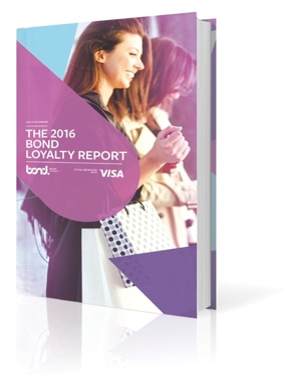Nearly 70 percent of consumers modify brands they engage with to earn points; Most loyalty programs fall short when it comes to personalization and customer experience
Toronto & New York, June 7, 2016 — Bond Brand Loyalty, North America’s leading brand loyalty agency, today released its sixth annual consumer loyalty report. The Canadian edition of the 2016 Bond Loyalty Report reveals that 80 percent of consumers say that loyalty programs make them more likely to continue doing business with brands. Despite this, the report finds that many programs are missing the opportunity to personalize offers and communications. Only 12 percent of Canadian respondents are very satisfied with the level of personalization they’re getting from brands; yet, satisfaction is 14 times higher when programs are highly personalized. When it comes to customer experience only 9 percent strongly agree that a brand or program representative makes them feel special and only 14 percent of respondents feel that the program experience is consistent across varied touch points (such as online, by email, by phone and in person).
The 2016 Bond Loyalty Report, conducted in collaboration with Visa, is the largest study of its kind. The report captures responses from roughly 12,000 U.S. and 7,000 Canadian consumers, and covers more than 58 dimensions of loyalty program performance including program mechanics, communications, rewards, needs fulfillment, loyalty emotional and behavioural outcomes, and brand alignment.
Year-over-year program satisfaction is steady at 32 percent even as loyalty solutions continue to innovate, indicating that member expectations are increasing just as quickly as programs are evolving. Developing meaningful loyalty programs that meet customers’ needs while deepening their relationship with brands is a difficult challenge, but when designed and operated effectively can reduce program costs and strongly influence consumer behaviour.
Loyalty impact
Program Satisfaction, Brand Alignment and Rewards Redemption
Demographic differences
Mobile is a strategic advantage (but missed opportunity)
Leaders in Loyalty
The 2016 Bond Loyalty Report performs in-depth profiling of more than 280 loyalty programs across key sectors including payment, retail, hospitality, airlines, gas, dining, CPG, coalition and others. Some of the top Canadian loyalty programs leaders within their sectors based on overall member satisfaction include Shoppers Drug Mart Optimum, Metro & Moi, My Starbucks Rewards, Johnson & Johnson Healthy Essentials and the PC Financial Debit Card.
Informal Loyalty Brands Perform Well
The study also looked at a number of informal loyalty brands—these are brands without a formal loyalty program, but who engage in many similar mechanics to keep their customers happy and loyal. The study provides insights into what these brands are doing well, and how these learnings can be applied to formal loyalty programs. Top informal programs ranked on member satisfaction include Dollar Shave Club, Netflix and Apple Genius.
“Marketers are telling us that loyalty program investments are paying off in a big way,” said Bob Macdonald, President and CEO of Bond Brand Loyalty. “This report arms decision makers with the critical insights required to build better strategies, keep up with consumer expectations, and drive more profitable outcomes for brands.”
For more information about the 2016 Bond Loyalty Report and to download a free copy of the Executive Summary, visit http://info.bondbrandloyalty.com/2016-loyalty-report.
About Bond Brand Loyalty
Bond Brand Loyalty is a management-owned agency that specializes in building brand loyalty for North America's most influential and valuable brands. Bond Brand Loyalty’s mission is to make marketing more rewarding for customers, richer and more resilient for brands, and more profitable for our clients. We build measurable, authentic and long-lasting relationships through a combination of services that includes loyalty solutions, customer experience, marketing research, customer analytics, live brand experiences and proprietary loyalty technology platforms. Visit our website, follow us on Twitter or contact us at 1-844-277-2663.
For more information, please contact:
Shannon Wojcik
585-831-6267
shannon@galvanizeworldwide.com
###